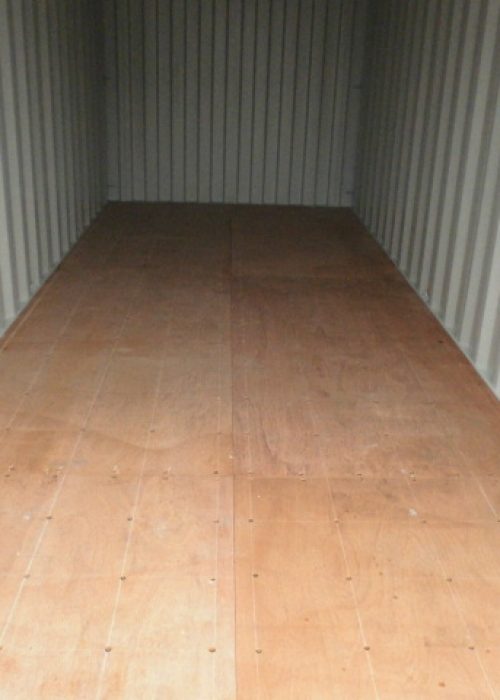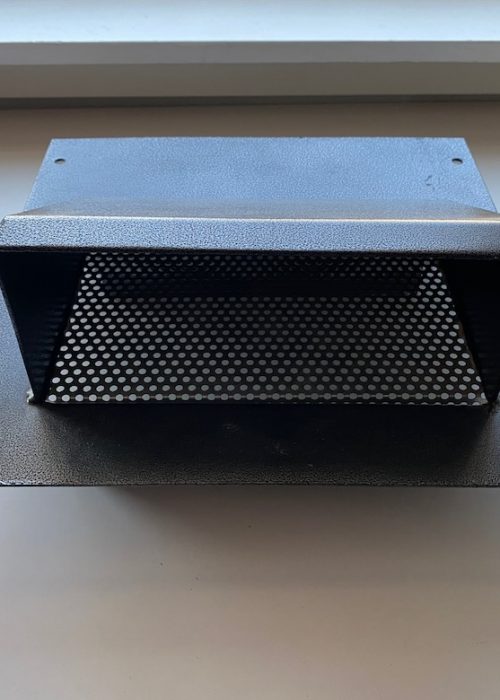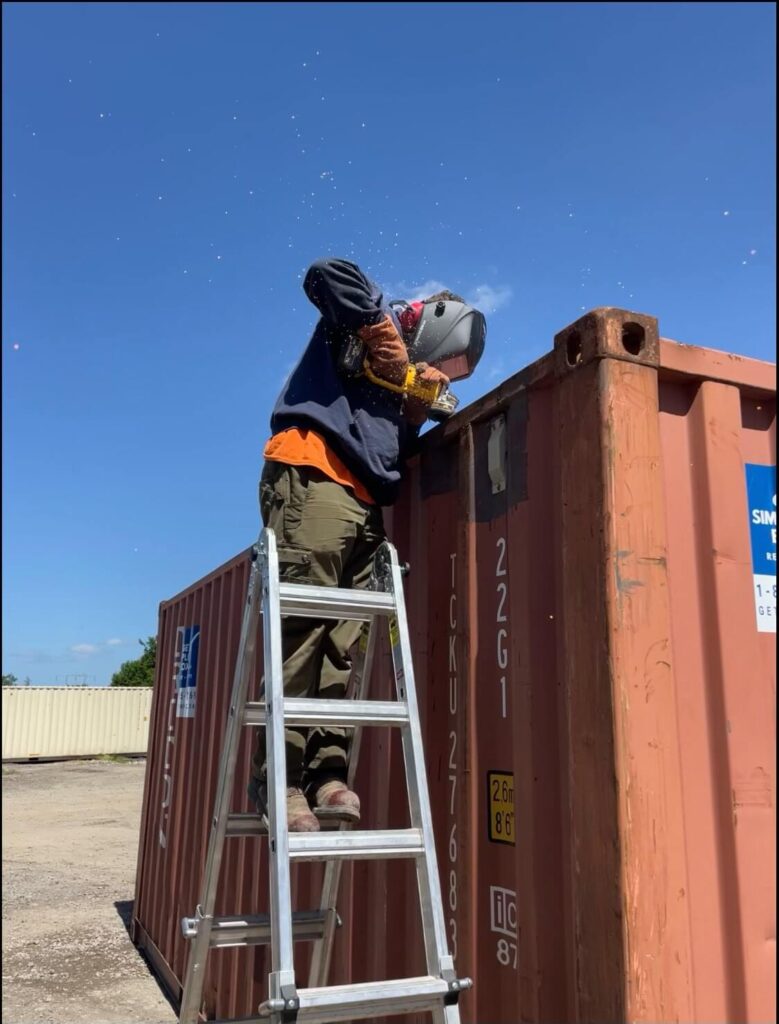
How to Properly Use Shipping Container Insulation for Winter Storage
Shipping Container Insulation Guide for Safe Winter Storage When the colder months arrive, many people turn to shipping containers as a dependable storage solution. Built
We specialize in custom shipping container modifications designed to fit your unique needs. Whether you’re building a container office, cabin, or tiny home, we’ll help bring your vision to life—while staying mindful of your time, space, and budget.
Strong and Secure
Cost-effective & Convenient
Simple Solutions

Looking to customize a shipping container? We specialize in a wide range of shipping container modifications to transform standard units into fully functional offices, cabins, tiny homes, workshops, and more. Our team can help you design the perfect custom shipping container to meet your needs—whether you’re focused on mobility, durability, comfort, or style.

The right shipping container door can transform your space. From roll-up doors and swing doors to sliding patio doors and lite kits, we offer a range of container door modifications to add convenience, security, and natural light. Whether it’s for an office, workshop, or studio, we’ll help you choose the best door to make your container more accessible and functional.
Install a 6-ft white steel roll-up door in the container’s side wall; includes framing, trim, and touch-up paint.
Starting at: $1,795 + tax
SKU: DOOR-ROLLUP-6-SIDE
Install a 6-ft roll-up door in the end wall with reinforced header; door is painted to match exterior.
Starting at: $2,420 + tax
SKU: DOOR-ROLLUP-6-END
Install an 8-ft roll-up door on the side wall for wide equipment access; framing and weather sealing included.
Starting at: $2,265 + tax
SKU: DOOR-ROLLUP-8-SIDE
Install a 10-ft side-wall roll-up door with full steel reinforcement and finish paint (quoted item).
Starting at: $2,890 + tax
SKU: DOOR-ROLLUP-10-SIDE
Install a 40-in insulated steel swing door, RH out-swing, with commercial lockset and two keys.
Starting at: $1,955 + tax
SKU: DOOR-SWING-40
Cut and insert a 24×24‑in insulated window kit into an existing steel door; includes trim and repaint (does not include door).
Starting at: $470 + tax
SKU: DOOR-LITE-KIT-2424
Retrofit an existing steel door with a 24×60-in insulated lite; price covers labor, trim, and sealant (does not include door).
Starting at: $780 + tax
SKU: DOOR-LITE-KIT-2460
Install a 71.5×79.5-in vinyl patio slider in the side wall with framing, flashing, and threshold trim.
Starting at: $1,720 + tax
SKU: DOOR-SLIDER-PATIO

Add comfort and curb appeal to your space with custom shipping container windows. From standard window kits to larger picture windows and sliding options, our container window modifications bring in natural light, improve ventilation, and enhance functionality. Whether you’re building a container office, living space, or pop-up shop, we’ll help you find the right window solution to brighten up your build.
Install a 36×36-in vinyl window (single-hung or slider) with drip cap and interior trim ring.
Starting at: $765 + tax
SKU: WINDOW-36
Install a 36×36-in slider window and weld an exterior steel mesh security screen; drip cap included.
Starting at: $1,080 + tax
SKU: WINDOW-36-SECURITY
Install a 48×48-in horizontal vinyl slider window flush with container ribs and fully caulked.
Starting at: $970 + tax
SKU: WINDOW-48-SLIDER
Install a 48×48-in vinyl single-hung window with flashing and interior casing.
Starting at: $970 + tax
SKU: WINDOW-48-SINGLE

Framing is the foundation of any great shipping container modification. Whether you’re planning interior walls, insulation, or electrical upgrades, our container framing solutions provide the structure you need to customize your space with confidence. From simple builds to full container conversions, we’ll help you get started with a strong, reliable frame that brings your vision to life.
Framing and sheeting are essential for turning a shipping container into a functional space. Done properly, they help ensure structural integrity, insulation, and a polished finish—whether the container will be used as a home, office, or storage unit.
Options include steel or wood framing, depending on the design and application.
Framing and sheeting improve temperature and moisture control inside the container.
Creates a smooth, attractive interior surface ready for daily use.
Framing a shipping container is essential for converting it into a functional space. It allows for the installation of insulation, electrical wiring, plumbing, and interior finishes so the container is comfortable and usable.
Framing is perfect for those seeking cost-effective and customizable solutions. It helps transform containers into livable, adaptable environments suited to a wide range of applications.
Steel framing offers superior strength and durability, making it ideal for supporting heavy modifications and ensuring long-term structural integrity.
Yes. Containers can be customized with doors and windows after framing and sheeting. It is important to provide proper structural support and weather sealing.
Consider aesthetics, insulation needs, and budget. Plywood is versatile and cost-effective, drywall creates a smooth interior finish, and metal sheeting offers durability and an industrial look.
Costs vary based on materials, complexity of modifications, and labor. For accurate pricing, request a project-specific estimate.
Frame the interior of a 10-ft container with 2×4 studs, 24 in OC; no sheathing or insulation.
Starting at: $705 + tax
SKU: FRAME-ONLY-10
Frame the interior of a 20-ft container with 2×4 studs, 24 in OC; ready for finish layers.
Starting at: $1,210 + tax
SKU: FRAME-ONLY-20
Frame the interior of a 40-ft container with 2×4 studs, 24 in OC; provides plumb surface.
Starting at: $2,110 + tax
SKU: FRAME-ONLY-40
Frame and sheath a 10-ft container with ½-in CCX plywood fastened to 2×4 studs.
Starting at: $1,795 + tax
SKU: FRAME-PLY-10
Frame and sheath a 20-ft container with ½-in CCX plywood; base trim around openings.
Starting at: $3,440 + tax
SKU: FRAME-PLY-20
Frame and sheath a 40-ft container using ½-in CCX plywood and construction adhesive.
Starting at: $5,625 + tax
SKU: FRAME-PLY-40
Build a non-load-bearing 2×4 partition wall faced with ½-in plywood; no door.
Starting at: $780 + tax
SKU: FRAME-PART-BLANK
Build a plywood-sheeted partition wall and set a pre-hung interior man door with casing.
Starting at: $1,250 + tax
SKU: FRAME-PART-DOOR
Construct a wood-framed end wall clad in T-111 siding and set a half-lite exterior door.
Starting at: $1,795 + tax
SKU: FRAME-WOOD-END
Fabricate a steel end wall, prime, and paint to match; door not included.
Starting at: $1,875 + tax
SKU: FRAME-STEEL-END

Insulation is a key part of any shipping container modification, helping control temperature, reduce condensation, and improve comfort. Whether you’re converting your container into a home, office, or studio, we offer container insulation solutions to fit your project.
Shipping container insulation is especially important when a container is converted into a livable or working space. The right insulation helps control temperature, reduce moisture and noise, and protect the container structure over time.
An insulation kit can be added to a shipping container to prepare it for use as an office, dry cabin, or workspace where temperature control is important.
Ideal for converting containers into offices, dry cabins, or other workspaces where controlling temperature and moisture is a priority.
View the full container insulation spec sheet for more technical details.
Insulation improves energy efficiency and thermal comfort inside the container, protects against condensation and moisture, and helps prevent extreme temperature swings.
Common options include:
Costs depend on insulation type, container size, and location. For a standard 20-foot container, prices typically range from $1,500–$5,000. Specific quotes from local providers will give the most accurate estimate.
Metal conducts heat and cold very efficiently. In winter the interior can feel extremely cold, and in hot weather the metal radiates heat, making the container feel like an oven without proper insulation.
Proper insulation helps control condensation. Spray foam insulation, in particular, creates a semi-permeable barrier that reduces moisture buildup on the interior surfaces.
Insulation panels can be customized to fit any container size, minimize waste during installation, and can be combined with other insulation solutions.
Spray foam is quick, easy, and effective. It reaches into gaps of various shapes and sizes and helps prevent condensation by sealing the surface.
Fiberglass insulation is an economical way to combat condensation and create a vapor barrier in shipping container projects.
Consider your climate, location, and container materials. High R-value spray foam and fiberglass panels are popular choices because they provide strong thermal performance and moisture control.
Contact local insulation or container-modification providers to obtain detailed, project-specific cost estimates.
Apply 1 in closed-cell spray foam to walls and ceiling of a 10-ft container for ~R-6.
Starting at: $1,565 + tax
SKU: INS-SPRAY-10
Apply 1 in closed-cell spray foam to walls and ceiling of a 20-ft container for ~R-6.
Starting at: $2,830 + tax
SKU: INS-SPRAY-20
Apply 1 in closed-cell spray foam insulation to a 40-ft container’s interior surfaces.
Starting at: $5,235 + tax
SKU: INS-SPRAY-40
Install R-15 fiberglass batts in the framed walls and ceiling of a 10-ft container (does not include framing).
Starting at: $940 + tax
SKU: INS-FIBER-10
Install R-15 fiberglass batts in the framed walls and ceiling of a 20-ft container (does not include framing).
Starting at: $1,720 + tax
SKU: INS-FIBER-20
Install R-15 fiberglass batts throughout the framed interior of a 40-ft container (does not include framing).
Starting at: $2,655 + tax
SKU: INS-FIBER-40
Spray 1 in foam then add R-13 batts in a 10-ft container, yielding ~R-20 insulation (does not include framing).
Starting at: $2,500 + tax
SKU: INS-COMBO-10
Spray 1 in foam then add R-13 batts in a 20-ft container, yielding ~R-20 insulation (does not include framing).
Starting at: $4,545 + tax
SKU: INS-COMBO-20
Combine 1 in spray foam with R-15 batts in a 40-ft container, yielding ~R-20 insulation (does not include framing).
Starting at: $7,890 + tax
SKU: INS-COMBO-40

Precision cutting and fabrication are the first steps in bringing your shipping container modification to life. From door and window openings to full structural changes, our expert team ensures clean, accurate cuts to match your design and layout.
Plasma-cut an opening in the container wall; per-linear-foot price includes edge prime.
Starting at: $70 + tax
SKU: CUT-OPEN-LF
Cut a 20-ft container in half, grind and prime edges, and prep fork pockets.
Starting at: $345 + tax
SKU: CUT-BOX-IN-HALF

A fresh coat of paint is the finishing touch on any great shipping container modification. Whether you’re going for durability, branding, or a clean modern look, we offer professional container painting in a variety of colors and finishes to match your vision.
Spray one coat of alkyd enamel on exterior walls of a 20-ft container; roof skim-coat blended.
Starting at: $705 + tax
SKU: PAINT-EXT-20
Spray one coat of alkyd enamel on exterior walls of a 40-ft container; masking included.
Starting at: $1,250 + tax
SKU: PAINT-EXT-40
Roll and spray low-sheen latex on interior walls/ceiling of an un-sheeted 20-ft container.
Starting at: $705 + tax
SKU: PAINT-INT-20
Apply low-sheen latex to interior of an un-sheeted 40-ft container; prime and finish.
Starting at: $1,250 + tax
SKU: PAINT-INT-40

Adding electrical wiring is a key step in most shipping container modifications, whether you’re building an office, studio, or living space. From basic lighting and outlets to full electrical packages, we’ll help power your container safely and efficiently.
Install an exterior 30‑amp quick-connect inlet with one interior duplex outlet.
Starting at: $195 + tax
SKU: ELEC-QUICK-CONNECT
Install one additional surface-mount 120 V duplex outlet on existing circuit.
Starting at: $80 + tax
SKU: ELEC-OUTLET-120
Mount an extra 4‑ft strip light on the ceiling tied into existing circuit.
Starting at: $170 + tax
SKU: ELEC-LIGHT-INT
Mount a weather-rated LED wall pack on container exterior and connect to lighting circuit.
Starting at: $280 + tax
SKU: ELEC-LIGHT-EXT
Wire a 20‑ft container with 1 4-ft strip light, 2 outlets, a switch, and quick‑connect inlet.
Starting at: $735 + tax
SKU: ELEC-BASIC-20
Wire a 40‑ft container with 2 strip lights, 4 outlets, a switch, and quick‑connect inlet.
Starting at: $970 + tax
SKU: ELEC-BASIC-40
Install 100-amp breaker panel PLUS 2 overhead lights, 4 wall outlets, and 1 dedicated 20A plug-in (complete interior office wiring).
Starting at: $2,655 + tax
SKU: ELEC-100A-PACKAGE

Climate control is essential for comfortable, usable spaces—and that’s why HVAC is a smart addition to your shipping container modification. From simple A/C units to full heating and cooling systems, we offer solutions to keep your container comfortable year-round.
Install a 10,000 BTU through-the-wall heat-and-cool unit in a window-style framed opening and weld a protective steel cage outside. Requires a 100-amp service panel so that it can run on its own 20-amp circuit.
Starting at: $1,720 + tax
SKU: HVAC-TTW-10K
Mount a 12 k BTU ductless heat‑pump system complete with line‑set and condenser bracket. Requires a 100-amp service panel so that it can run on its own 20-amp circuit.
Starting at: $3,360 + tax
SKU: HVAC-MINISPLIT-12K

The right flooring adds comfort, durability, and style to your shipping container modification. Whether you’re building a home, office, or retail space, we offer a range of flooring options to match your vision and stand up to daily use
Install commercial-grade luxury vinyl plank flooring over a 20-ft container floor.
Starting at: $1,640 + tax
SKU: FLOOR-VINYL-20
Install luxury vinyl plank flooring across a 40-ft container floor with trims.
Starting at: $2,970 + tax
SKU: FLOOR-VINYL-40

Proper airflow is essential for any shipping container modification. Adding vents helps reduce heat, moisture, and condensation—improving air quality and protecting your container’s interior for the long haul.
Passive & Turbo Vents rely on natural convection and wind-driven airflow to keep your container ventilated. Installed on the upper and lower container walls, they facilitate continuous air exchange without electricity.
Key Features:
Prevent Condensation: Stops moisture buildup, mold, mildew, and corrosion.
Temperature Regulation: Replaces hot, stale air with cooler fresh air.
Reduce Odors: Keeps air fresh and comfortable.
Supply a 6×9-in powder-coated wall vent with screen and mounting hardware for customer install.
Starting at: $115 + tax
SKU: VENT-PASSIVE-KIT
Installing passive vents is simple and effective. Place vents on the upper and lower walls of the container for optimal natural airflow.
Cut, mount, and seal a 6×9-in powder-coated wall vent in the container wall.
Starting at: $155 + tax
SKU: VENT-PASSIVE-INST
Solar Roof Fans and Electric Vents are powered to actively circulate air inside your container. Ideal when natural ventilation is limited, they maintain consistent airflow, regulate temperature, and reduce odors.
Advantages:
Consistent airflow and temperature control.
Improved comfort in enclosed containers.
Suitable for modified containers like container offices or homes.
Supply a self-powered solar roof vent/fan kit with flashing for customer installation.
Starting at: $390 + tax
SKU: VENT-SOLAR-ROOF-KIT
Installing solar or electric vents ensures maximum airflow and climate control. Proper placement and electrical setup are crucial for performance.
Cut roof opening, mount solar vent/fan, and seal fasteners for powered ventilation.
Starting at: $470 + tax
SKU: VENT-SOLAR-ROOF-INST
Our 4-Step Process is Simple and Straightforward.





We focus on being local, professional, and kind. If at any point you have questions or concerns, a local manager is standing by and ready to help within 1 business day.









We focus on being local, professional, and kind. If at any point you have questions or concerns, a local manager is standing by and ready to help within 1 business day.
We're looking forward to helping you get a Modified Shipping container. Fill out the form and we'll reply quickly with a no-pressure estimate.
"*" indicates required fields

Our Container Modification Catalog is your complete guide to customizing a shipping container. From doors and windows to insulation, electrical, and more—you’ll find everything you need to design a functional, personalized space.
In this video, we take you behind the scenes to show how a standard container is transformed step-by-step—from precision cutting and framing to insulation, doors, windows, flooring, and finishing touches. Whether we’re building an office, studio, or tiny home, you’ll see our expert team bring custom shipping container modifications to life.

Shipping Container Insulation Guide for Safe Winter Storage When the colder months arrive, many people turn to shipping containers as a dependable storage solution. Built
Explore our Learning Center for expert advice on shipping container modifications, portable storage, moving solutions, and container delivery. With easy-to-browse articles, how-to videos, product comparisons, and FAQs, it’s your go-to resource for ideas, answers, and inspiration. Whether you’re planning a custom build or comparing options, start here to discover what’s possible.

Got questions about shipping container modifications? You’re in the right place. Whether you’re customizing a container for storage, building a mobile office, or adding doors, windows, or insulation, our expert team is here to help. Below, you’ll find answers to the most frequently asked questions about modifying shipping containers for residential, commercial, or construction use. Learn what’s possible, how much it costs, and how to get the most out of your modified container.
Shipping containers can be modified for various purposes, including structural changes (like adding doors and windows), utility installations (such as plumbing and electrical systems), interior customization (like partitions and furnishings), and exterior enhancements (such as siding and weatherproof coatings).
Yes, modified containers can be designed as livable spaces by incorporating insulation, proper ventilation, electrical and plumbing systems, and comfortable interior layouts. Many people use them as tiny homes, vacation cabins, or guest houses.
To ensure compliance with local building codes, it’s essential to consult with local authorities or a professional architect or contractor familiar with container modifications. They can guide you on permits, zoning regulations, and safety standards.
Modified containers provide secure, weather-resistant storage solutions that can be easily transported and placed in various locations. They are durable, cost-effective, and customizable to fit specific storage needs, making them ideal for residential, commercial, and industrial applications.
While some modifications can be done as DIY projects, it’s often best to hire professionals for complex changes, especially those involving structural alterations, electrical work, and plumbing, to ensure safety and quality.
Costs can vary widely based on the type of modifications, materials used, and labor required. Simple modifications may start around a few thousand dollars, while extensive customizations can run into tens of thousands. It’s best to create a detailed budget based on your specific needs.
The timeline for modifying a shipping container depends on the complexity of the project. Simple modifications may take a few weeks, while more extensive customizations can take several months. It’s important to discuss timelines with your contractor to set realistic expectations.
Yes, modified containers are considered environmentally friendly as they repurpose shipping containers that would otherwise go unused or be discarded. By transforming them into functional spaces, you help reduce waste and promote sustainability in construction, especially when combined with eco-friendly materials and practices.
With a name like “Simple Box” we don’t want our own focus on simplicity to limit your creativity. We have also completed modification work for:
FROM $750
Add Interior LED lights, exterior lights, quick- connect plug, duplex outlets, 100-amp panel and more.
FROM $1950
2×4 framing with plywood sheeting or drywall and spray-foam or fiberglass insulation.
FROM $1950
2×4 framing with plywood sheeting or drywall and spray-foam or fiberglass insulation.
Options are limitless! We’ve done enough projects to know what we do best and when to hand-off.
FROM $1850
6-10 foot doors may be installed on the side wall, smaller sizes also available for the end wall.
FROM $1550
Insulated steel entry door available in slab or half-lite.
FROM $1400
Residential grade sliding glass door can be installed on a side wall with an overhead drip cap.
Swing doors in shipping containers provide easy access and secure closure for loading and unloading goods.
FROM $650
Industrial Alkyd Enamel can be color matched (you provide Sherwin Williams color code).
FROM $550
Standard residential vinyl or security windows installed on side or end wall with drip cap.
FROM $2000
Choose from solar vents or passive vents, all the way up to a full mini-split HVAC system.
Harnesses solar power, reducing energy costs and environmental impact.
With a name like “Simple Box,” we focus on doing a few things really, really well.
Looking for Container House Prices or Shipping Container Home Plans?
We try to incorporate the motto “Keep It Simple” into all that we do. That philosophy carries over to our container modification department as well.
Our highly-experienced mod team has a good feel for the work we do best (windows, doors, and insulation). And we partner with others who can do the more detailed finish work of a Tiny Home or House made out of a Shipping Container.
Although there are a world of possibilities for what you could convert your container into, we focus on doing a few types of modifications very well:

Shipping container homes offer a sustainable, cost-effective, and customizable housing solution, transforming durable steel containers into modern, eco-friendly living spaces.

Shipping container offices provide a flexible, secure, and eco-friendly workspace solution, offering customizable designs that can be easily relocated to suit any business need.

A shipping container transformed into a concession stand offers a durable, portable, and customizable solution for serving food and beverages at events or pop-up locations.